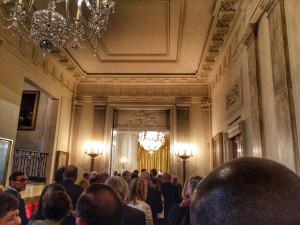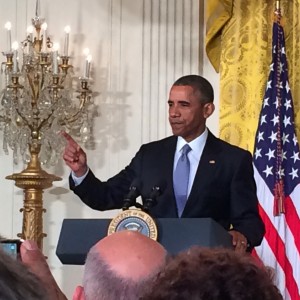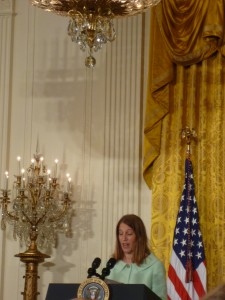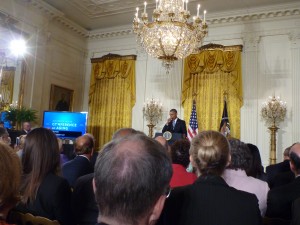The White House Conference on Aging (WHCOA) was this week. It’s a once-in-a-decade gathering of people who are passionate about older Americans. The next time this conference occurs, I’ll be 66 and my siblings will be in their 60s with one turning the corner to 70. With a little luck and some healthy choices, we’ll be active and engaged with our communities well into our golden years.
One thing that is clear from the 2015 conference is that, as a country, we still have a lot of hard work to do if our communities are going to be ready for me and my siblings. That said, I was proud to represent geriatrics health professionals at the WHCOA and it gave me hope that the type of future we envision for older adults could be a reality (especially on the cusp of some momentous news today from the U.S. Senate—you’ll just have to keep reading to find out more!).
First, the things that made me proud…
Falls Prevention Takes Center Stage at the Centers for Disease Control & Prevention: In 2001, the American Geriatrics Society (together with the British Geriatrics Society and the American Academy of Orthopedic Surgeons) released our first Guideline for the Prevention of Falls in Older Persons, with an updated guideline issued in 2010. This was seminal work, and not just for the AGS. In fact, our most recent guideline informed the U.S. Centers for Disease Control and Prevention (CDC) work on creating the Stopping Elderly Accidents, Deaths, & Injuries (STEADI) initiative that was announced at the WHCOA. STEADI provides educational tools to healthcare professionals that can help them identify individuals at risk for falls, understand how to modify certain risks that they are likely to find, and learn how to implement effective options for preventing falls altogether. The CDC has been working with Epic Systems Corporation (an electronic health record technology provider) and EPIC will be rolling out a clinical support tool for falls assessment. This resource will make it easier for ALL healthcare providers to screen for falls, intervene to reduce risk, and provide follow-up care. AGS members are leading the STRIDE study that is testing a multifactorial fall injury prevention strategy that is being co-funded by the Patient-Centered Outcomes Institute (PCORI) and the National Institute on Aging (NIA). I’m proud of AGS and our members—we built the foundation for STEADI and, looking towards the WHCOA in 2025, I expect that we will have progressed even further in our understanding of how to prevent older adult falls.
Medicare & Geriatrics Health Professions Funding: President Obama had some good news for geriatrics health professionals, as well—noting that we are working to implement Medicare payment models that support the quality rather than the quantity of care. AGS has been at the forefront of efforts that will benefit beneficiaries by ensuring that clinicians are supported to provide care coordination, care transitions, and advance care planning. We continue to advocate for payment models that support geriatrics health professionals in doing what they love to do: maximize the function and quality of life of the older adults they serve. Look for more news from us on the recently released 2016 proposed physician fee schedule rule in the coming weeks.
Not to be outdone, Health and Human Services (HHS) Secretary Sylvia M. Burwell announced $35 million in funding for more than 40 Geriatrics Workforce Enhancement Programs (GWEPs) in some 29 states. The AGS has been a leading advocate on behalf of funding for geriatrics workforce health professions and this is a key advocacy issue for the Eldercare Workforce Alliance, which I co-convene. Many of the programs being supported by this new round of grants have AGS members leading the team and several will be using AGS content (from GeriatricsCareOnline.org) in their educational efforts. But the good news does not stop there. Our longstanding partner, The John A. Hartford Foundation, had some news of its own as it announced that it would be devoting $2 million to supporting the work of the GWEPs. The AGS is looking forward to helping advance the GWEPs to improve the quality of health care for older Americans by:
- changing training environments to integrate geriatrics into healthcare delivery overall;
- training more healthcare professions to assess, address, and understand the conditions that impact older adults; and
- delivering community-based programs to provide patients, families, and caregivers with knowledge and skills to drive their own care and well-being.
We will continue to advocate for expanded funding for eldercare workforce development with a particular focus on ensuring that we are supporting geriatrics health professionals who want to pursue careers as clinician educators. That workforce is essential to ensuring the competence of the entire workforce that cares for older adults.
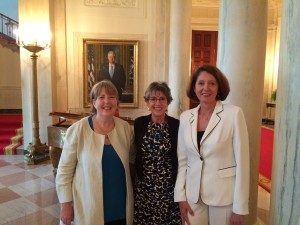
Nancy Lundebjerg (AGS CEO), Robyn Stone (ED, LeadingAge Center for Applied Research) and Cheryl Phillips (LeadingAge SVP of Public Policy & Advocacy)
Now the things that made me hopeful…
The Promise of Technology: A number of technology initiatives were announced at the conference, but three stood out for me:
- By September of this year, aggregated federal data about older Americans will be made more easily available on Data.gov, the repository for the U.S. government’s open data. will open a wealth of information to researchers who are working hard to understand the challenges and opportunities we all face as we age.
- LeadingAge is partnering with Hewlett-Packard (HP) to use HP’s 3D computing platform to tap into that newly open federal data to challenge innovators to create technology-driven tools that improve the lives of older adults and their families. I am really looking forward to seeing this partnership in action at the next LeadingAge HackFest .
- Silicon Valley looks like it’s starting to pay closer attention to the needs of older adults. Seth Sternberg, the founder of Honor, an innovative “in-home” care platform for seniors, spoke about what he’s trying to do to better link older adults and their families to paid caregivers. Honor, which is currently available in the San Francisco Bay area, announced that it will be providing $1 million dollars’ worth of free care in 10 communities. As a caregiver daughter, I can see huge benefits in a platform that can connect me with those who take care of my mother at home. Heck, as a 56-year-old on the cusp of cataract surgery, I can see a huge benefit if I need short-term help myself!
The Energy of Advocates: It’s hard not to feel uplifted when amongst a group of like-minded people, and this occasion was no different. I left the conference knowing that we have a lot of work to do but believing that together we can accomplish great things. This is important in a year when we are celebrating the 50th aniversary of the Older Americans Act (OAA), Medicare, and Medicaid, as well as the 80th anniversary of Social Security. Pausing to celebrate these programs and to look towards the future is important for renewing our collective energy and drive to improve the lives of older adults.
Finally, thanks, congratulations, and what you can do for older Americans…
Thanks to AARP for funding a series of regional events that led up to the conference and for supporting the WHCOA with a significant amount of staff time and energy. Thanks to Nora Super (Executive Director of the WHCOA), her White House team, AARP, and many others, the conference had the largest reach ever, with four regional events and a fifth gathering in the East Wing of the White House on July 13th. More than 600 watch parties were held across the United States as the WHCOA was live-streamed for the first time in history. As for me, I was honored to be amongst friends and colleagues who have devoted their lives to improving the health and quality of life of older people.
And a big congratulations to Nora Super—and her extraordinary team—for pulling this event together. It’s not easy to plan a conference and it’s particularly hard to plan one on a shoe string. Why a shoe string, you might ask. Well, the OAA—which funds this conference, among other things—has not been reauthorized by Congress. But the really good news for the 11 million Americans who are served by OAA programs is that the full Senate passed the Older American Act Reauthorization Act of 2015 on July 16, 2015. It now goes to the House where hopefully it will be smooth sailing—another big victory, and another milestone for older adult care.
So what can you do for older Americans? The Administration on Community Living (ACL) has a great infographic about OAA programs that’s definitely worth reading and sharing. You probably know someone who uses Meals on Wheels or who has tapped into the aging network to identify home care workers, find transportation, or any number of services that support our friends and neighbors so they can age in place. Take a minute to visit our Health in Aging Advocacy Center and let your representative know that you support reauthorization of the OAA. It’s the least we can do for our older loved ones.
For more information on the WHCOA, check out the fact sheet put together by the White House.

